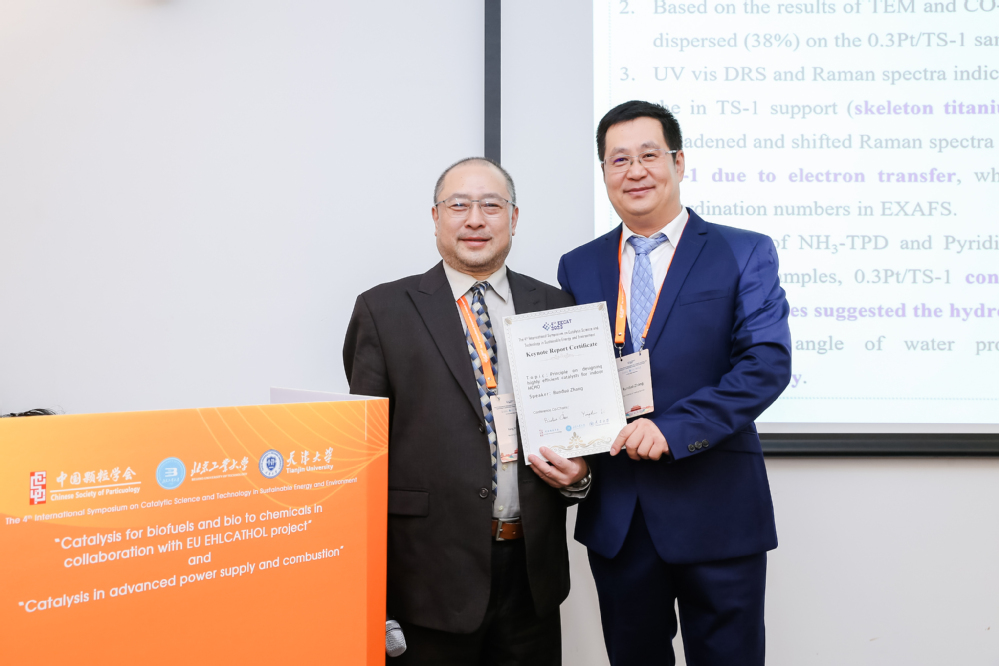重点实验室主任张润铎教授出席“The 4th International Symposium on Catalytic Science and Technology in Sustainable Energy and Environment”并作主旨报告
会议名称:The 4th International Symposium on Catalytic Science and Technology in Sustainable Energy and Environment
会议时间:2023.10.15-2023.10.18
报告题目:Principle on designing highly efficient catalysts for indoor HCHO


Principle on Designing Highly Efficient Catalysts for Indoor HCHO Elimination at Essentially Ambient Temperature
Zhaoying Di, Xiaonan Guo, Bin Kang, Hongxia Chen, Runduo Zhang*
Beijing University of Chemical Technology, Beijing 100029, China
zhangrd@mail.buct.edu.cn
Abstract: Formaldehyde (HCHO) is considered to be one of the typical indoor pollutants commonly released from furniture and decorating materials.Long-term exposure to even ppm levels of HCHO may cause various discomforts and diseases.Room-temperature catalytic oxidation has been recognized as the most promising strategy for the removal of HCHO due to its mild reaction conditions and no need for extra energy. At present, the noble metal supported catalysts and the bulk transition-metal-oxide catalysts have been investigated for HCHO elimination.Compared with transition-metal oxides, noble-metal nanoparticles are usually regarded as suitable active sites with an ideal ability to adsorb gaseous O2 and activate O-O bonds, which facilitates the oxidization of HCHO into carbon dioxide (CO2) and water (H2O) at relatively low temperatures.However, in order to achieve the complete conversion of HCHO at room temperature, it has been reported that the loading amount of noble metal in the catalysts is commonly high (about 1%).The wide applications of those noble-metal catalysts are accordingly restricted due to their high costs and limited resources. Therefore, it is meaningful to reduce the loading amount of precious metal by its well utilization as well as develop a novel catalyst both ensuring satisfactory HCHO purification efficiency at room temperature and essentially cutting down the corresponding cost.
Zeolites have attracted increasing interests as the excellent supports for preparation of the catalysts for the HCHO oxidation due to their advantage for adsorption of HCHO by uniform and controllable micropores. In our previous work, we prepared typical hydrophobic Titanium silicalite-1 (TS-1), aluminosilicate (ZSM-5) and pure silica (S-1) zeolites with the same MFI topology as supports loaded with 0.3 wt% Pt for the oxidative elimination of HCHO. The 0.3Pt/TS-1 sample exhibited excellent catalytic performance for the removal of HCHO at room temperature, which is attributed to its better hydrophobicity and the strong interaction between Ti species and the active component Pt to promote its dispersion. Based on this advantage, we have successfully prepared TS-1 zeolites with different Si/Ti molar ratios encapsulated Pd catalysts (Pd@TS-1(x)) by a ligand stabilized strategy. The Pd NPs with an average size of 2.2–3.5 nm were uniformly dispersed into the matrix of TS-1(x) but obviously aggregated Pd NPs (5.1 nm) were observed on the surface of TS-1 for TS-1 supported Pd catalyst. The Pd@TS-1(50) sample exhibited the best catalytic activity for HCHO oxidation at room temperature. Compared to TS-1(50) supported Pd catalyst, the better catalytic performance of Pd@TS-1(50) sample was mainly attributed to high Pd dispersion, small size of Pd NPs, and fast surface reaction.
Key words: formaldehyde, catalytic oxidation, room temperature, zeolite
References
[1] Z. Di, H. Chen, R. Zhang et al., Appl. Catal. B: Environ., 304 (2022) 120843.
[2] H. Chen, R. Zhang, W. Bao et al., Catal Today 355 (2020) 547-554.
[3] H. Chen, R. Zhang, W. Bao et al., Appl Catal B Environ., 278 (2020) 119311.



